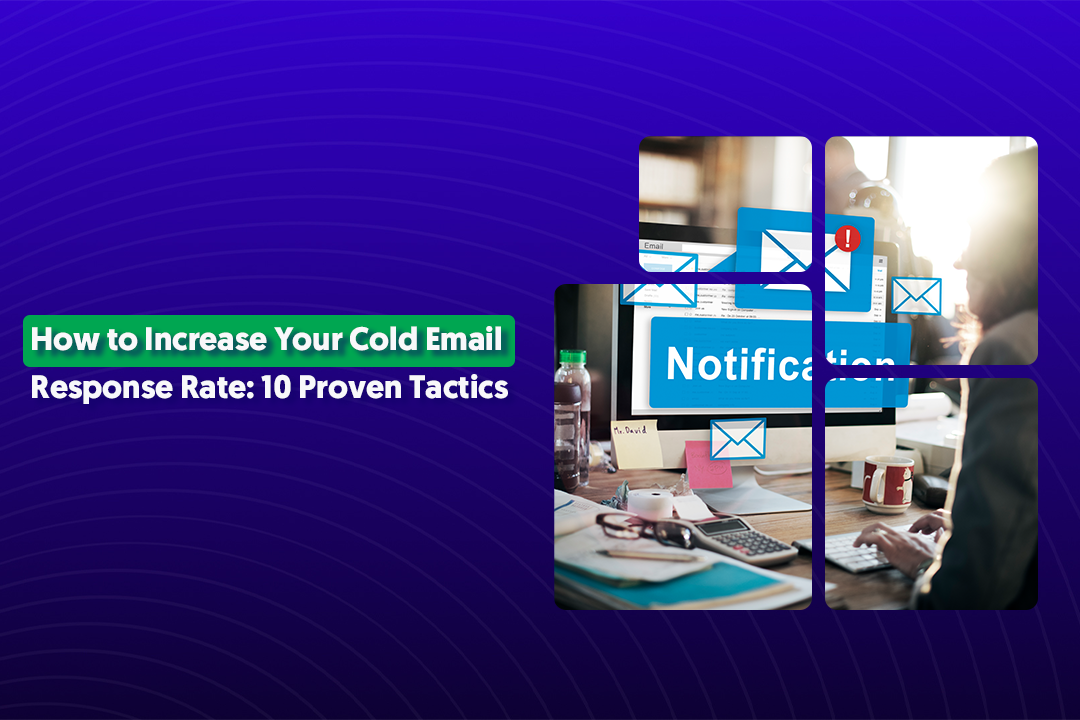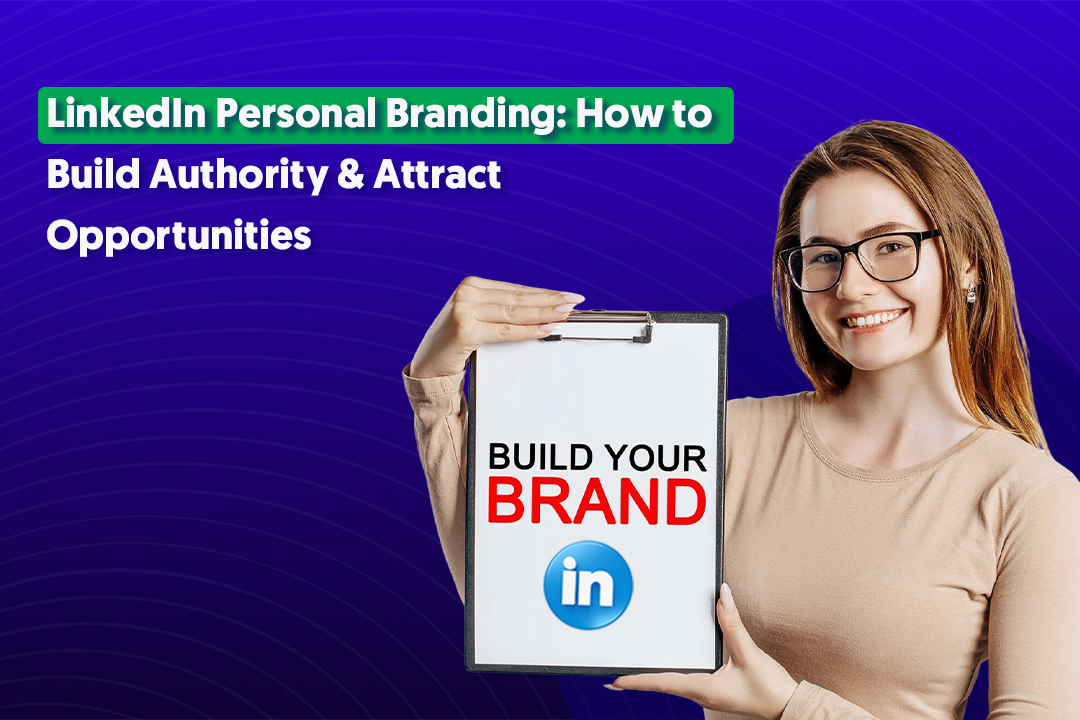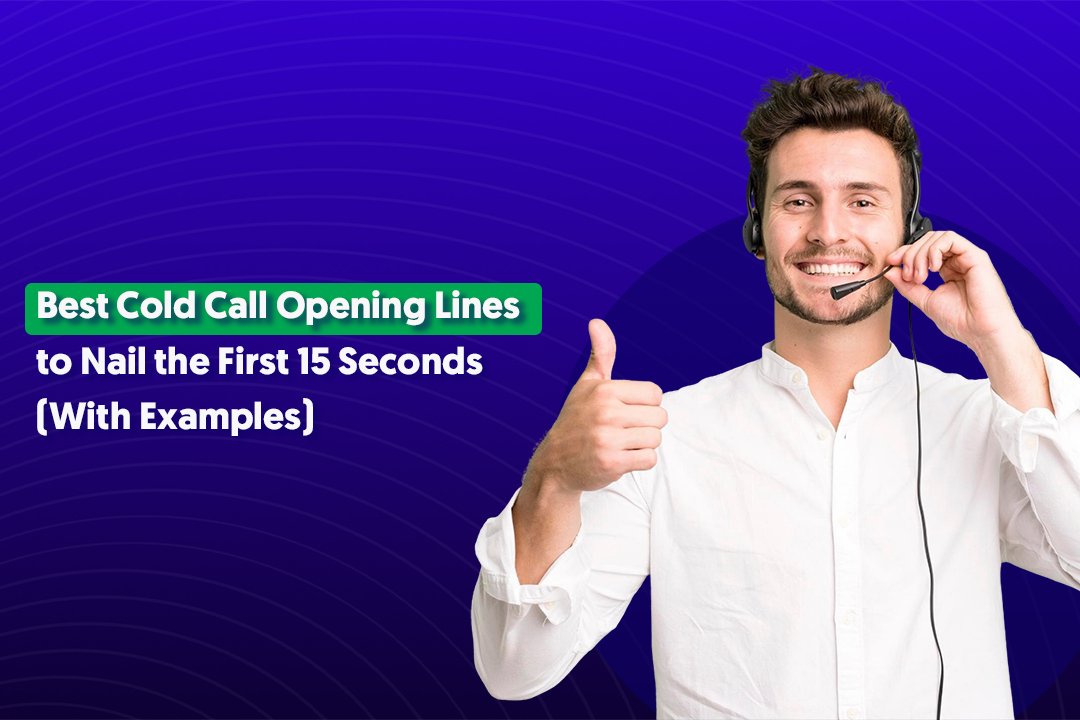Table of Content
Key Takeaways
- Consistent, value-first content establishes authority and attracts ideal prospects without aggressive selling.
- Personalized connection requests with 2-3 sentences referencing specific relevance achieve 80%+ acceptance rates.
- A strategic 3-step messaging sequence (value, engagement, transition) naturally converts connections into sales conversations.
- LinkedIn Groups provide untapped opportunities to demonstrate expertise and connect with highly targeted prospects.
- Implement a daily 15-30 minute LinkedIn routine to systematically generate 30+ qualified leads monthly.
Tired of spending hours on LinkedIn with little to show for it? Imagine transforming your profile from a digital business card into a lead-generating machine that consistently brings in 30+ qualified prospects every single month.
LinkedIn isn't just another social media platform – it's the world's largest professional network where decision-makers actively seek solutions.
While most users barely scratch the surface of LinkedIn's potential, savvy professionals are quietly converting connections into clients using proven lead generation strategies that actually work.
In this guide, we’ll reveal the exact LinkedIn lead generation system we've used to help businesses across industries fill their pipelines with qualified leads.
Ready to stop hoping for leads and start creating a predictable flow of opportunities? Here's an interesting video for you before we dive in!
Why LinkedIn Should Be Your #1 Lead Generation Platform in 2025
If you're not prioritizing LinkedIn in your 2025 lead generation strategy, you're leaving money on the table.
The numbers don't lie: LinkedIn generates 277% more leads than Facebook and Twitter combined, with conversion rates 3x higher than other social platforms.
Why?
Because people come to LinkedIn with business on their mind – they're actively seeking solutions, not just scrolling mindlessly between cat videos.
What truly sets LinkedIn apart is its precision targeting capabilities. Where else can you filter prospects by industry, company size, job title, and even recent career changes?
Add to this LinkedIn's algorithm prioritizing business content, and you have the perfect environment for connecting with high-value prospects who actually want to hear from you.
The question isn't whether you should be generating leads on LinkedIn; it's whether you can afford not to.
7 Proven LinkedIn Lead Generation Strategies That Actually Work
No more throwing content into the LinkedIn void and hoping something sticks. These seven battle-tested strategies work together as a complete system, designed to consistently attract and convert your ideal prospects.
At Cleverly, we’ve distilled years of LinkedIn lead generation experience into this framework that balances automation with authentic relationship-building – the perfect recipe for generating 30+ quality leads month after month without spamming.
Strategy #1: Optimize Your LinkedIn Profile for Lead Attraction
When prospects land on your profile, you have seconds to convince them you're worth connecting with.
Profile Headline That Converts:
- Create a benefit-driven headline that includes your target keywords
- Focus on the outcomes you deliver rather than just your job title
- Include industry terms that your ideal clients are searching for
Example: "Helping B2B SaaS Companies Increase Demo Bookings by 40% | LinkedIn Lead Generation Specialist"
Your profile photo and background image are equally crucial. A professional headshot increases profile views by 14x, while a branded background image with a clear call-to-action creates immediate visual impact.
About Section Optimization:
- Begin with a compelling hook addressing your prospect's pain points.
- Structure the middle section around client problems you solve.
- Include 2-3 brief client success stories as social proof.
- End with a specific call-to-action and contact information
Pro tip: Use keywords naturally throughout this section for search visibility
Featured Section Must-Haves:
- Client case studies with specific results.
- Downloadable lead magnets or resources.
- Testimonial graphics or recommendation highlights.
- A link to your calendar for easy booking.
Every element of your LinkedIn profile should answer the prospect's unspoken question: "Why should I connect with this person?" When optimized correctly, your profile becomes the foundation of your entire LinkedIn lead generation system.
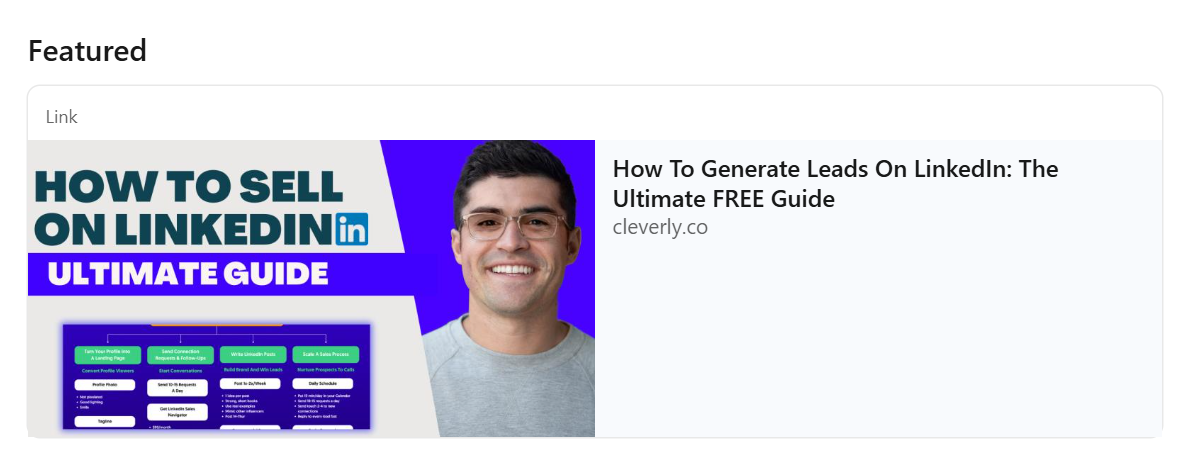
Strategy #2: Content Marketing That Positions You as an Industry Authority
Consistent, strategic content is the engine that drives your LinkedIn lead generation system. Publishing valuable insights positions you as a trusted authority while simultaneously expanding your reach to new potential leads.
Content Types That Generate Maximum Engagement:
- Text-only insight posts (surprisingly, these often outperform visual content).
- Carousel posts showcasing step-by-step processes or before/after results.
- Short-form case studies highlighting specific client outcomes.
- Polls that spark discussion around industry pain points.
- Personal stories that connect professional insights with relatable experiences
The LinkedIn algorithm rewards content that keeps users on the platform. Focus on providing complete value within your posts rather than constantly driving traffic elsewhere.
An example:
Content Themes That Attract Ideal Clients:
- Challenge common industry misconceptions or "best practices".
- Share specific frameworks or methodologies you use with clients.
- Document real results with actual metrics (with client permission).
- Address the exact pain points your ideal clients experience.
- Offer actionable tips they can implement immediately.
Consistency trumps frequency. It's better to publish 2-3 high-quality posts weekly than daily content that lacks substance. The key is establishing a reliable rhythm your audience can count on.
Example:
Content Optimization Tactics:
- Front-load value in the first 3 lines before the "see more" cutoff.
- Include 3-5 relevant hashtags (mix of broad and niche terms).
- End posts with a clear, specific question to drive comments.
- Respond to every comment within 24 hours to boost algorithm visibility.
- Repurpose your best-performing content in different formats.
The goal isn't just engagement – it's attracting the right people into your ecosystem.
Each piece of content should serve as a filter, resonating deeply with ideal clients while naturally qualifying out poor-fit prospects.
Strategy #3: Advanced LinkedIn Search Techniques to Find Your Ideal Prospects
Stop waiting for leads to find you. LinkedIn's powerful search capabilities let you proactively identify and target your ideal prospects with surgical precision.
Mastering these search techniques creates a consistent pipeline of qualified opportunities.
Boolean Search Operators for Precision Targeting:
- Use quotation marks for exact phrase matching: "marketing director".
- Leverage AND/OR operators to combine criteria: "VP" OR "Director" AND "Marketing".
- Exclude terms with NOT: "marketing" NOT "assistant".
- Group complex searches with parentheses: ("CMO" OR "Chief Marketing Officer") AND "SaaS".
- Combine operators for hyper-targeted results that match your exact buyer persona.
Free LinkedIn accounts provide valuable search functionality, but Sales Navigator is truly a game-changer for serious lead generators.
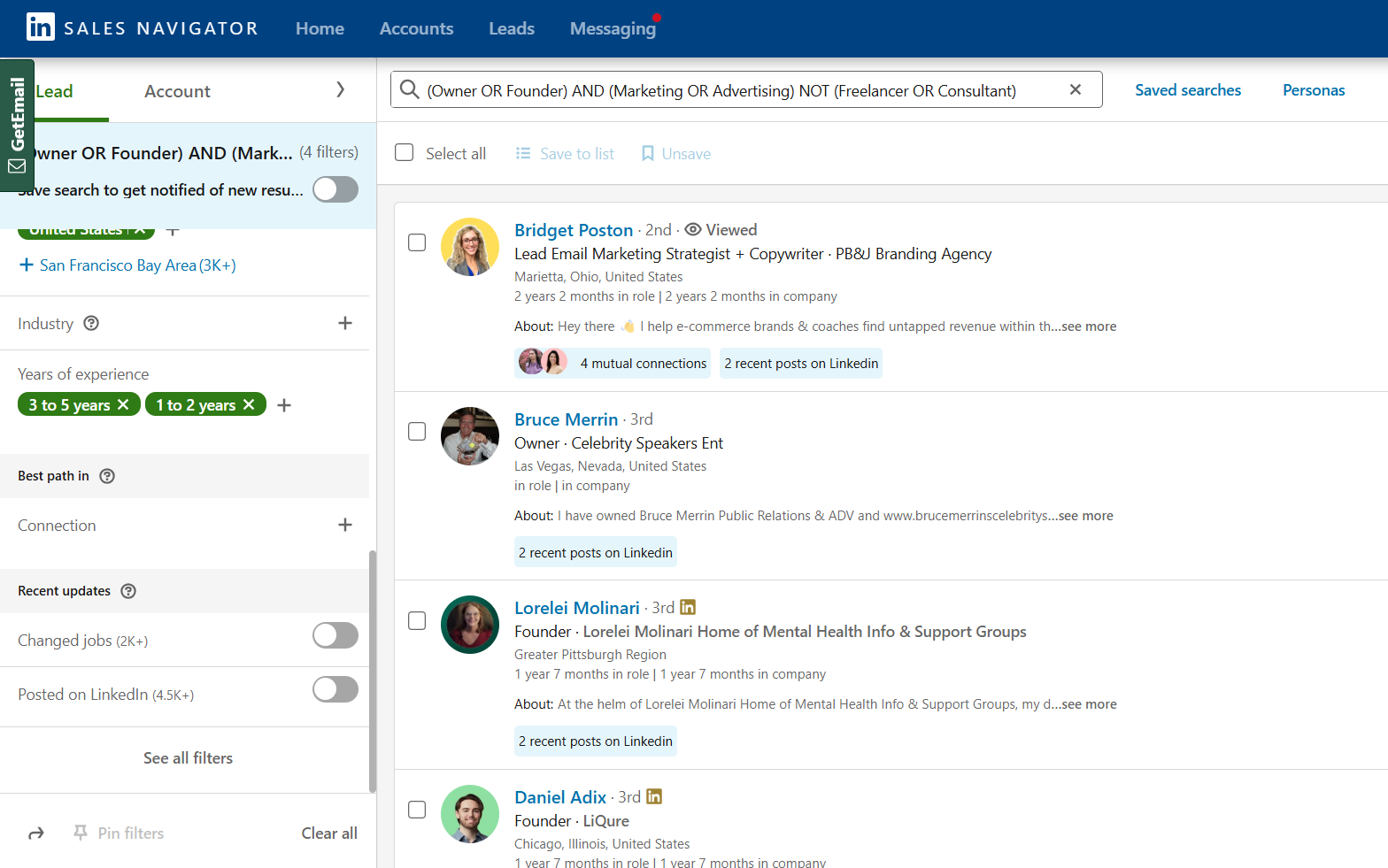
Sales Navigator Power Techniques:
- Save complex searches for one-click access to fresh prospects.
- Receive automatic alerts when new prospects match your criteria.
- Filter by company headcount changes, growth signals, and posting activity.
- Identify prospects who've changed roles in the last 90 days (often eager to prove value).
- Layer geographic and industry filters for territory-specific targeting.
Creating a systematic approach turns ad-hoc searching into a lead generation machine. Check this video!
Building Your Prospect Pipeline System:
- Develop 3-5 core search templates based on your ideal client profiles.
- Set a consistent rhythm for search activity (daily or weekly).
- Create saved lists organized by industry, role, or priority level.
- Track outreach using a simple spreadsheet or CRM integration.
- Aim to identify 50-100 new prospects weekly to fuel your connection strategy.
Always look beyond just job titles. Searching for prospects who engage with relevant content topics, follow specific companies, or participate in certain LinkedIn groups reveals hidden opportunities your competitors are missing.
📢 Pro Tip: For personalization, use the "All Filters" option to add layers like company size, years in position, and educational background.
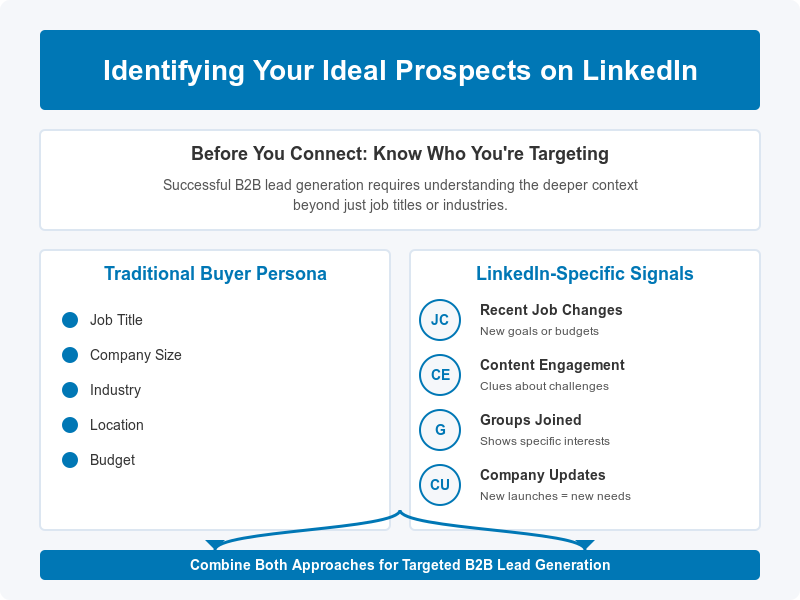
Strategy #4: Connection Request Strategies With 80%+ Acceptance Rates
The difference between mediocre and exceptional results lies in your approach to making that crucial first impression.
Done right, your connection strategy becomes a predictable lead generation system.
Personalization That Gets Attention:
- Reference a specific piece of content they've recently shared or engaged with.
- Mention a mutual connection or group membership that creates instant relevance.
- Acknowledge a recent company achievement or personal milestone.
- Identify a specific industry challenge you both care about solving.
- Keep it brief – 2-3 sentences maximum with clear value proposition.
The key is moving beyond superficial personalization to demonstrate genuine interest and relevance.
Connection requests have limited character count, so make every word count. Your goal isn't to sell – it's to start a conversation.
High-Converting Request Templates:
- Content Engagement: "Hi [Name], your insights on [topic] in your recent post really resonated with me, especially [specific point]. I'd love to connect and exchange ideas on [shared interest]."
- Mutual Connection: "Hi [Name], I noticed we're both connected with [mutual contact]. I've been following your work in [industry/company] and would value adding you to my professional network."
- Industry Relevance: "Hi [Name], as fellow [industry] professionals tackling [specific challenge], I thought connecting could be valuable. I'm particularly interested in your approach to [relevant topic]."
After sending requests, implement a strategic follow-up system for connections who accept.
Follow-Up Strategy For New Connections:
- Send a genuine thank-you message within 24 hours of acceptance.
- Include an open-ended question related to their work or industry.
- Share a relevant resource without expectation (article, guide, or tool).
- Wait 2-3 days before following up if no response.
- Never immediately pitch your services – focus on building rapport first
Connection Tracking System:
- Set weekly connection request goals (25-50 per week is sustainable).
- Track acceptance rates by template to identify what's working.
- Document key information about each prospect for future personalization.
- Tag new connections in a CRM or spreadsheet for organized follow-up.
- Aim for a minimum 70% acceptance rate (80%+ is achievable with refinement).
Remember, Quality > quantity. Ten deeply researched, highly personalized connection requests will generate better results than 100 generic ones.
Your goal is building a network of potential clients, not random connections.
Strategy #5: Messaging Sequences That Convert Connections into Leads
Random, sales-focused messages get ignored, while strategic messaging sequences build trust and naturally progress toward business discussions. The right approach transforms your inbox into a lead generation engine.
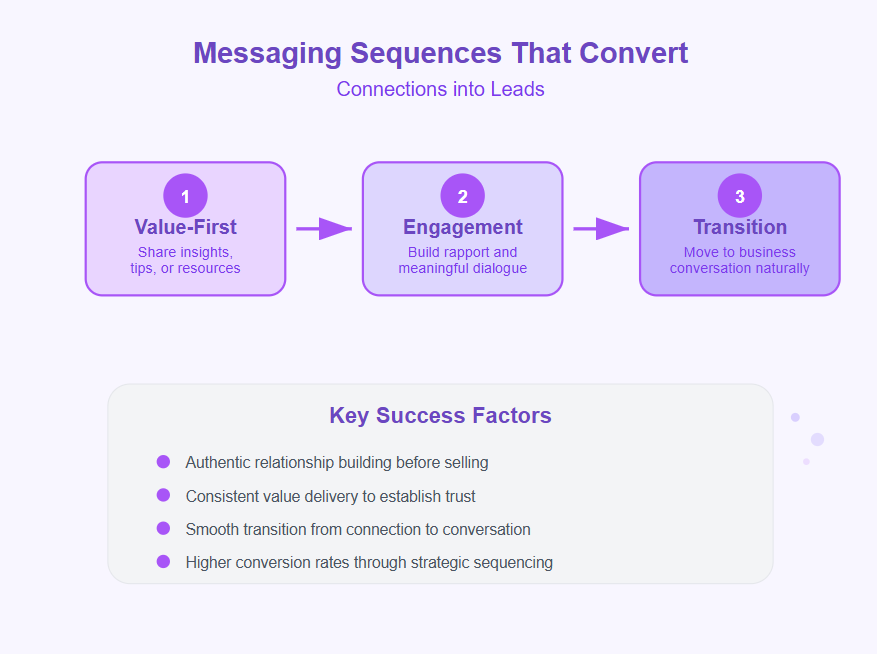
The 3-Step Messaging Framework:
- Value First: Offer insights or resources without asking for anything
- Engagement: Ask questions that spark meaningful conversation
- Transition: Move from LinkedIn chat to a more personal medium (call, Zoom, or email)
This framework respects your prospect's time while demonstrating your expertise.
Message 1: Value Delivery (1-2 days after connecting)
- Thank them for connecting with a personalized note.
- Share a specific insight related to their industry or recent content.
- Include a relevant resource (article, template, or quick tip).
- End with an open-ended question that's easy to answer.
Example: "By the way, I noticed [observation about their business]. I recently created this [resource] that might help. What's been your biggest challenge with [relevant topic] lately?"
But hey wait, don’t let your patience. Wait for a response before sending your next message.
Message 2: Deepening Engagement (3-5 days after response)
- Acknowledge their response thoughtfully.
- Share a brief success story relevant to their situation.
- Ask a more specific question about their business goals.
- Position yourself as a resource, not a salesperson.
Example: "That's interesting about [reference their previous response]. We helped a similar [company type] overcome that by [brief solution]. Are you currently focused on improving [specific metric or outcome]?"
Message 3: Transitioning the Conversation (2-3 days after second response)
- Express appreciation for the conversation.
- Suggest continuing the discussion in a more convenient format.
- Offer clear value for the call/meeting (not a "discovery call").
- Make it easy to say yes with specific options.
Example: "I've enjoyed our conversation about [topic]. I have some specific ideas for your [challenge mentioned]. Would a 15-minute call be helpful? I'm available Tuesday or Wednesday afternoon if that works for you."
Key Messaging Principles:
- Keep messages conversational and brief (3-5 sentences maximum).
- Space messages appropriately (never send multiple unanswered messages).
- Focus on their challenges rather than your solutions.
- Ask questions that demonstrate your expertise.
- Track response rates to optimize your approach
📌 Important note is that successful messaging isn't about clever tactics—it's about starting genuine conversations that provide value before expecting anything in return.
When done correctly, prospects will often ask for the meeting before you even suggest it.
Strategy #6: Leveraging LinkedIn Groups for Targeted Lead Generation
While most users focus solely on their feed, savvy marketers are quietly connecting with highly targeted prospects through strategic group participation.
The key is quality engagement over quantity.
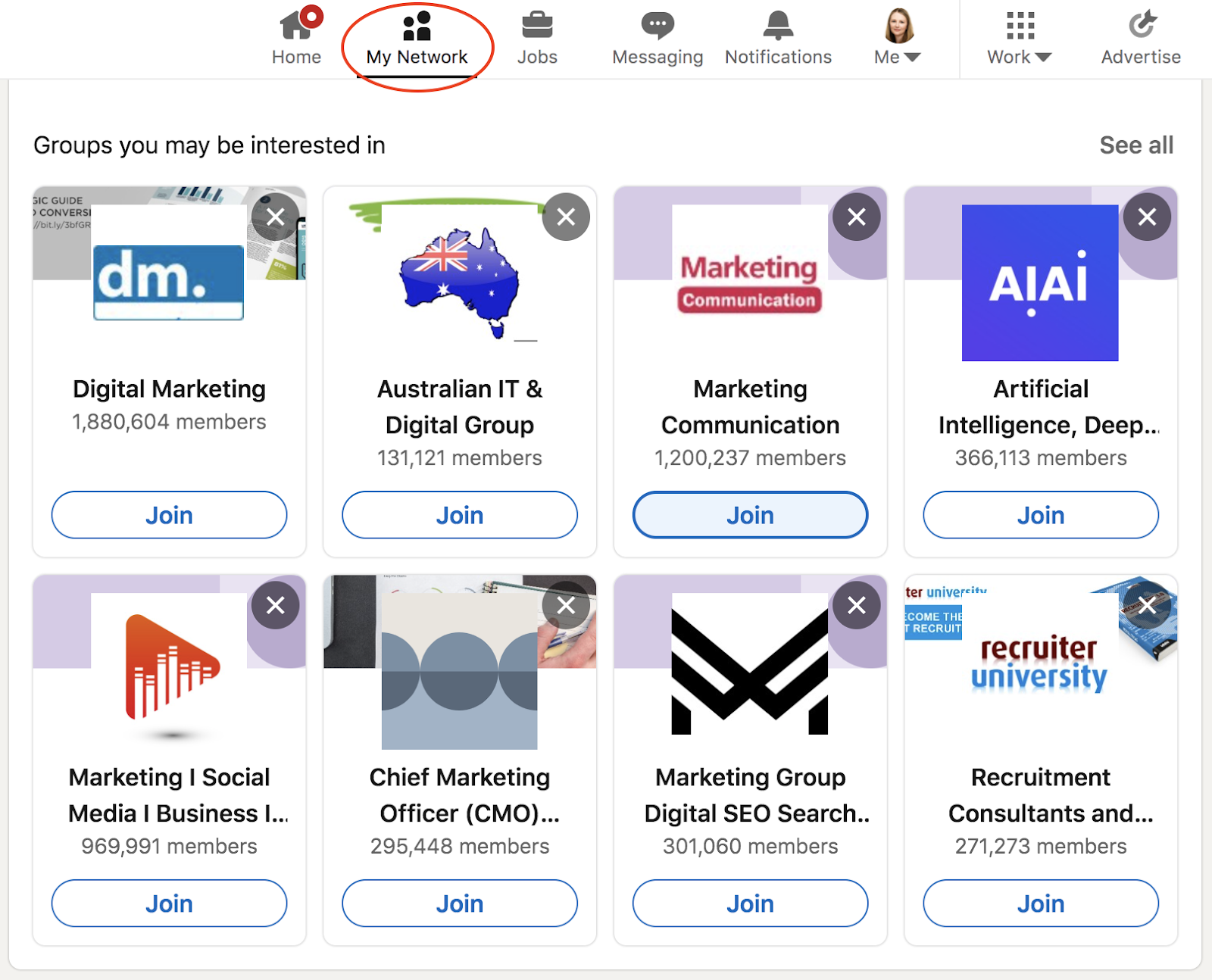
Finding and Joining the Right Industry Groups:
- Search for groups using industry-specific keywords and phrases.
- Prioritize groups with active discussions and regular engagement.
- Look for groups with 1,000-10,000 members (large enough for reach, small enough for visibility).
- Join groups where your ideal clients participate, not just peers.
- Review group rules carefully – some prohibit self-promotion or direct messaging
As we mentioned earlier in this blog, quality matters more than quantity. Five active, relevant groups will generate more leads than 20 dormant ones.
Positioning Yourself as a Helpful Resource:
- Spend 1-2 weeks observing group dynamics before actively participating.
- Answer questions thoughtfully with detailed, actionable advice.
- Share relevant case studies or experiences without direct promotion.
- Use the "know, like, trust" approach rather than immediate selling.
- Tag and credit other group members to build relationships
The fastest way to establish authority is by helping others solve their problems publicly.
Each helpful response showcases your expertise to the entire group.
Content Strategies Specific to Group Engagement:
- Create posts that address common questions you've observed in the group.
- Share industry insights with a question that encourages discussion.
- Post "what would you do?" scenarios that spark debate.
- Share quick wins and actionable tips specific to group interests.
- Repurpose your best-performing feed content with group-specific angles
Consistency is key – aim for 2-3 meaningful group interactions weekly across your chosen groups.
Moving Group Connections into Your Direct Network:
- Send personalized connection requests referencing specific group interactions.
- Mention the shared group and specific discussion in your connection message.
- Follow up with value-adding resources related to their group questions.
- Create a private message that continues a public group conversation.
- Invite group connections to relevant events or webinars you're hosting.
Group Engagement Tracking:
- Document which groups generate the most meaningful conversations.
- Track which topics receive the highest engagement within each group.
- Set weekly engagement goals (comments, posts, connections).
- Monitor which group connections convert to actual leads.
- Gradually phase out low-performing groups and replace with new ones.
Remember: Groups are communities, not advertising platforms. Always try delivering value and building genuine relationships, you'll naturally attract leads who already recognize your expertise – making the conversion to client significantly easier.
Strategy #7: Scaling Your LinkedIn Lead Generation (Without Getting Flagged)
Even the most effective LinkedIn strategies face a critical challenge: scaling your efforts without sacrificing quality or violating LinkedIn's terms of service.
The right balance of automation and personalization creates a sustainable system that generates leads while you focus on closing deals.
Safe Automation Practices:
- Focus on workflow automation rather than interaction automation.
- Use scheduling tools for consistent content posting.
- Create templated messages that still require personalization.
- Set up saved searches that deliver fresh prospects automatically.
- Implement tracking systems to monitor outreach effectiveness.
LinkedIn actively penalizes accounts using aggressive automation, making a thoughtful approach essential.
Creating Scalable Outreach Processes:
- Develop a content calendar with themed content categories.
- Create a library of customizable message templates for different scenarios.
- Establish a consistent daily routine (15-30 minutes) for genuine engagement.
- Batch similar activities (connection requests, messaging, content creation).
- Document your process so team members can assist with specific tasks.
When looking to truly scale your LinkedIn lead generation efforts, professional solutions can provide significant advantages.
⭐ At Cleverly, we've refined LinkedIn lead generation into a science, helping over 10,000 clients—including brands like Amazon, Google, Uber, PayPal, Slack, Spotify and more —generate consistent, qualified leads.
Our clients have achieved remarkable results, including $312 million in pipeline revenue and $51.2 million in closed revenue through strategic LinkedIn outreach.

🙌 If you're interested in generating qualified B2B leads through LinkedIn using our data-driven approach and specialized tools, click here for more information.
Setting Up Your 30+ Leads Per Month LinkedIn System
Generating 30+ leads monthly isn't about sporadic LinkedIn activity. It's about implementing a consistent, methodical system.
Here's your roadmap to turn the above strategies into a reliable lead generation engine.
Daily Activities (15-30 minutes):
- Respond to all comments and messages within 24 hours.
- Send 10-15 personalized connection requests to researched prospects.
- Engage meaningfully on 3-5 posts from your target audience.
- Share one piece of valuable content in your feed or relevant groups.
- Review profile views and send personalized messages to interested visitors
Weekly Activities (1-2 hours):
- Publish 2-3 high-quality content pieces focused on your expertise.
- Review analytics to identify top-performing content and messages.
- Refresh your saved searches to identify new prospect opportunities.
- Follow up with prospects who've engaged but haven't converted.
- Update your CRM or tracking system with new leads and interactions.
Monthly Optimization (2-3 hours):
- Analyze your conversion metrics at each pipeline stage.
- Refine messaging templates based on response rates.
- Update your profile to highlight new results and testimonials.
- Identify and join new groups where your prospects are active.
- Review overall strategy and adjust based on performance data.
Expected Timeline for Results:
- Week 1-2: Profile optimization and initial connection building.
- Week 3-4: First conversations and relationship development.
- Week 5-6: Early leads begin to emerge from consistent activity.
- Week 7-8: System refinement based on initial results.
- Month 3+: Consistent flow of 30+ qualified leads monthly.
The system works when you combine data-driven optimization with authentic relationship building.
Implement these strategies consistently, and you'll create a predictable pipeline of opportunities that continues scaling with your business.
Conclusion: Your LinkedIn Lead Generation Action Plan
LinkedIn isn't just another social platform—it's the most powerful B2B lead generation tool available today when approached strategically.
The seven strategies we've covered form a complete system that consistently delivers qualified leads while positioning you as an authority in your space.
Start by optimizing your profile to attract the right prospects. Develop a content strategy that showcases your expertise. Master advanced search techniques to identify ideal clients.
Implement personalized connection and messaging sequences that build relationships naturally. Leverage groups for targeted opportunities, and scale your efforts through thoughtful automation.
The difference between struggling for leads and consistently generating 30+ opportunities monthly isn't about working harder—it's about implementing a proven system and optimizing it over time.
👉 And, if you’re looking for professional help to create lead pipelines worth $300 Million, feel free to reach out here!
Frequently Asked Questions
1. How long does it take to start generating leads on LinkedIn?
With consistent implementation of these strategies, you can expect initial conversations within 2-3 weeks and your first qualified leads by week 4-6. Reaching the full 30+ leads per month typically occurs after 2-3 months of system refinement.
2. Do I need LinkedIn Premium or Sales Navigator to generate leads effectively?
No, you can implement most strategies with a free account, though Sales Navigator significantly enhances your targeting capabilities and provides valuable insights that improve conversion rates, making it worth the investment for serious lead generators.
3. How much time should I dedicate to LinkedIn lead generation daily?
Consistency trumps duration—15-30 minutes of focused daily activity yields better results than sporadic longer sessions. With practice and systems in place, you can generate 30+ leads monthly with about 5-7 hours of total LinkedIn activity per week.
4. Is it better to focus on connection quantity or quality?
Quality connections always outperform quantity. Ten deeply researched, personalized connection requests will generate better results than 100 generic ones. Focus on connecting with prospects who match your ideal client profile rather than building a large but irrelevant network.
5. How can I measure the ROI of my LinkedIn lead generation efforts?
Track metrics at each stage: profile views, connection acceptance rates, message response rates, meetings scheduled, and deals closed. Calculate your customer acquisition cost by dividing your time investment (valued at your hourly rate) by the number of customers acquired through LinkedIn.
6. What's the biggest mistake people make with LinkedIn lead generation?
The most common mistake is jumping straight to pitching services without building relationships first. Successful LinkedIn lead generation follows the "know, like, trust" sequence—providing value and establishing credibility before attempting to convert prospects into leads.



